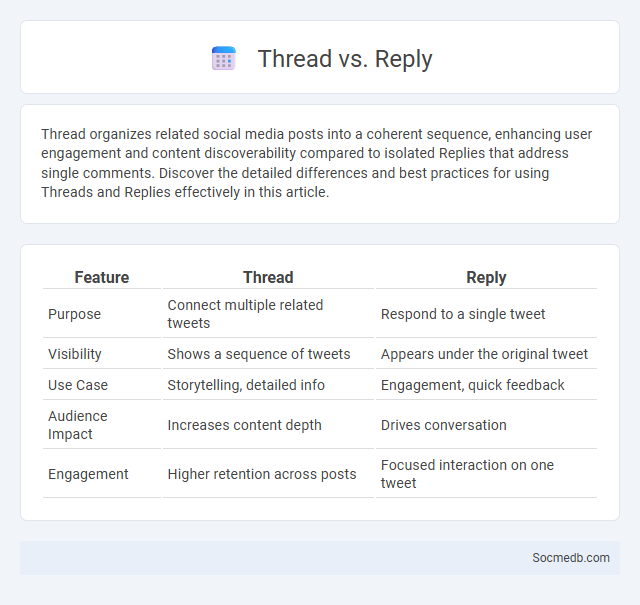
Photo illustration: Thread vs Reply
Thread organizes related social media posts into a coherent sequence, enhancing user engagement and content discoverability compared to isolated Replies that address single comments. Discover the detailed differences and best practices for using Threads and Replies effectively in this article.
Table of Comparison
| Feature | Thread | Reply |
|---|---|---|
| Purpose | Connect multiple related tweets | Respond to a single tweet |
| Visibility | Shows a sequence of tweets | Appears under the original tweet |
| Use Case | Storytelling, detailed info | Engagement, quick feedback |
| Audience Impact | Increases content depth | Drives conversation |
| Engagement | Higher retention across posts | Focused interaction on one tweet |
Introduction to Threads and Replies
Threads and replies are essential features of social media platforms that facilitate organized conversations and community engagement. Threads group related posts or comments into a single, continuous flow, making it easier for users to follow discussions on specific topics. Replies allow direct responses to individual posts within threads, enhancing interaction and fostering dynamic, focused exchanges among users.
Defining a Thread in Online Communication
A thread in online communication refers to a series of connected messages or posts grouped under a single topic, typically found on social media platforms like Twitter, Reddit, and Facebook. This structure enables users to follow and contribute to evolving discussions, maintaining context and coherence. Threads enhance user engagement by organizing conversations and facilitating easier navigation through related comments and replies.
What is a Reply?
A reply on social media is a direct response to a specific post or comment, allowing users to engage in conversations and clarify points within threads. It helps create interactive discussions by addressing the original content or other replies, increasing user engagement and content visibility. Replies are essential for building community interaction and fostering dynamic communication across platforms like Twitter, Facebook, and Instagram.
Thread vs Reply: Key Differences
Threads organize conversations by grouping related replies under a single post, making it easier to follow the flow of discussion compared to individual replies that stand alone. Replies respond directly to a specific message within a thread or post, allowing You to engage precisely with particular points while maintaining context. Understanding the key differences between threads and replies enhances Your social media interactions by improving clarity and engagement.
Importance of Threads in Discussions
Threads in social media discussions enhance organized conversations by linking related posts, enabling users to follow and contribute to specific topics more efficiently. They improve clarity and context by grouping replies, which fosters deeper engagement and better understanding among participants. This structured format supports dynamic interactions, making it easier to track multiple viewpoints and maintain continuity in digital communication.
When to Use a Thread vs a Reply
Use a thread on social media to explore complex topics, share detailed updates, or maintain a coherent narrative across multiple posts, enhancing user engagement and content visibility. Opt for a reply when responding directly to specific comments or questions, fostering focused conversations and building community interaction within an existing post. Strategic use of threads versus replies optimizes communication effectiveness and audience retention on platforms like Twitter and Reddit.
Threaded Conversations vs Linear Replies
Threaded conversations organize social media interactions by grouping replies under the original post, enhancing context and making it easier to follow multiple discussion strands. Linear replies display comments sequentially, which can simplify reading but often leads to fragmented conversations and missed nuances. Choosing threaded conversations for Your social media strategy improves engagement by maintaining clarity and continuity in user interactions.
Pros and Cons of Threaded Messaging
Threaded messaging enhances social media conversations by organizing replies into clear, linear sequences, improving readability and context retention in group chats and comment sections. It allows users to follow specific discussion threads without confusion, facilitating more meaningful interactions and reducing message clutter. However, threaded messaging can also create fragmented discussions that isolate comments, making it harder for users to see the conversation in its entirety and sometimes leading to overlooked replies.
Best Practices for Managing Threads
Effective management of social media threads involves consistently monitoring conversations to promptly address comments and questions, enhancing user engagement and satisfaction. Organize threads by categorizing related topics and using clear, concise language to maintain clarity and ease of navigation. Your proactive approach in moderating discussions ensures a positive community environment and strengthens your online presence.
Choosing Between Thread and Reply for Effective Communication
Choosing between a thread and reply on social media impacts the clarity and organization of online conversations. Threads are ideal for presenting detailed, sequential information, facilitating deeper engagement and easy reference, while replies work best for brief interactions and direct responses to specific comments. Effective communication depends on selecting the format that enhances message coherence and user interaction within platforms like Twitter, Facebook, and Instagram.
 socmedb.com
socmedb.com